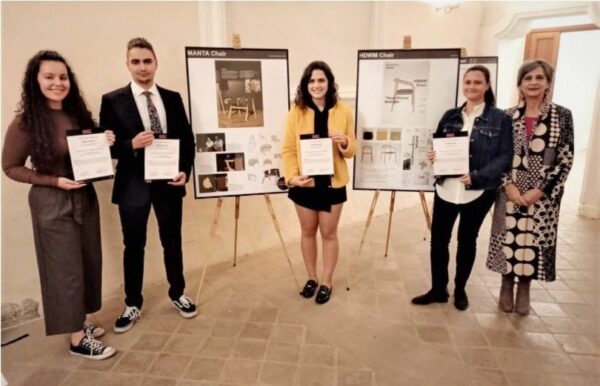
Estudantes de Design da Universidade de Aveiro ganham o 1.º e o 2.º prémios da International Design Competition for Students A CHAIR with a Story. Design a Chair with a Strong Element of Heritage, que decorreu de 15 de Abril a 1 de Agosto de 2021 como uma das atividades do projeto europeu Erasmus+ CRAFT – Cultural Heritage (CRAFT- KA203-2018-010) com a responsabilidade nacional da professora Fátima Pombo, docente do DeCA e membro do ID+.
Dos projetos submetidos provenientes de várias universidades europeias, o júri escolheu anonima e unanimemente Manta Chair (1.º prémio) da autoria de Clara Serrano, Cristiana Farinha, João Paulino e Rui Fernandes (alunos do 2.º ano do Mestrado em Engenharia e Design de Produto), HDWM Chair (2.º prémio) da autoria de Gaëlle Pillault (aluna 2.º ano do Doutoramento em Design) e Albicastrense Chair (3.º prémio) da autoria de Mariana Lopes (aluna do 3.º ano da Licenciatura em Design de Interiores e Equipamento do Instituto Politécnico de Castelo Branco).
A entrega dos prémios teve lugar no final da Opera Craft (na qual os estudantes participaram) na Chiesa dell’Annunziata em Pesaro no dia 29 de Outubro de 2021. A exposição dos posters com os projetos vencedores foi visitada por um público interessado que dialogou com os estudantes. Na primeira imagem podemos ver, da esquerda para a direita, Clara Serrano, João Paulino, Cristiana Farinha, Gaëlle Pillault e a professora Fátima Pombo.
O júri foi constituído por:
Professora Fátima Pombo (Universidade de Aveiro), Chair da Design Competition,
Designer Hans Thyge Ravnkjær (Hans Thyge & Co), Copenhaga,
Professora Anna Marie Fisker (Universidade de Aalborg),
Professora Ana Maria Fernández (Universidade de Oviedo).
A apreciação do júri sobre as 3 cadeiras vencedoras foi a seguinte:
1st Prize Manta Chair:
The project is a refined balance between the inspirational sources and a modern expression based on our cultural heritage. The simple structure with the shepherds stick turned around becoming a handle or signature of the chair enhance the project with both humor and refined reference to our heritage. Taking starting point in the life of the shepherd, digging into mythical references of nature, man and his herd, this was transformed into a storytelling of high level. The chair is well proportioned, and the simple upholstery wrapped around the structure also gives an intriguing balance between something noble and yet simple and rough. As such the project opens chains of associations and references to cultural heritage, which makes the project rich and complex and still simple and direct.
The project is a fine example of how we can use our cultural heritage and transform it into a relevant object of our time.
2nd Prize HDWM Chair:
The project is a fine modern version of the old steambending Viennese chair combined with Bauhaus influences. The contrast between the tight expression of “New Nordic” of our time blended with the romantic simplicity of bended round sticks creates an interesting hybrid. The chair evokes something familiar in us and at the same time it provokes very dry and formal attitude. It is harmonic and functional as well as minimalistic. The project is presented in a tasteful vibrant graphic layout which underlines the modernity of the project sitting on the shoulders of one of the most archetype iconic chairs of our times. The chair will have some constructional challenges, which can be solved, and the jury misses a clearer storytelling of the historic references, which leads to the fine final solution.
3rd Prize Albicastrense Chair:
The project combines an old poetic and refined handcraft technique, normally used for cloth, with a piece of upholstered furniture. The delicate embroidery is placed on the square architectural form almost like a mural on a building which creates a nice contrast between the formal and the expressive. The research composed of poetic sketches shows nicely the power in the local iconography in the 1800 of the Castelo Branco regions in Portugal and the contrast between the formal archetype form and the fine detailing based on cultural heritage in the decoration is an interesting theme. The jury is though missing a more distinct attitude in the design of the structure and in the overall visual approach of the project presentation.
O projeto CRAFT consiste numa Parceria Estratégica Erasmus+ que inclui seis parceiros no total, representando cinco países europeus (Dinamarca, Portugal, Espanha, Itália e Eslovénia) com participação de diferentes áreas disciplinares. Mais informações podem ser consultadas no website da Unidade de Investigação ID+.
Recent Posts
-
Teresa Franqueira elected vice-president of the CUMULUS Association
03-07-2025 11:03 -
OPENING of CALL FOR ONE (1) SCIENTIFIC RESEARCH SCHOLARSHIP (BI) UNDER THE R&D PROJECT FAIST – Smart, Sustainable, Technological Agile Factory
18-06-2025 10:06 -
COST Action DESIGNAE has been selected for funding by the European Cooperation in Science & Technology (COST)
21-05-2025 13:55